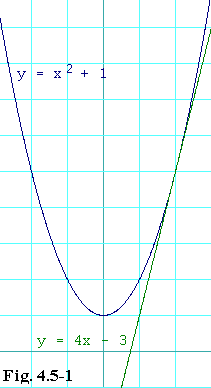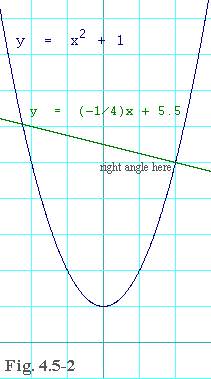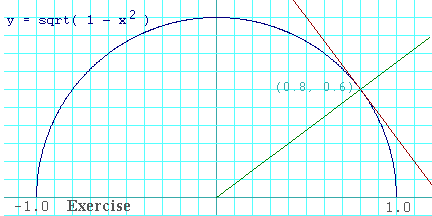

You've probably already seen it in your homework problems -- "find the equation of the line that is tangent to bloppity-blop curve at the such-and-such point." And if you haven't yet, you soon shall. It will be on the exam as well.
A line that is tangent to a curve has two properties:
The equation of a line is, as you learned in algebra
y = mx + b eq. 4.5-1So all you have to do is find m and b.
Let's take the second property first. The slope of the line is m. That value has to match the derivative of the curve at the point they give you. So for finding m you need to know the derivative of the curve. And you need to evaluate it at the point they give in the problem. And that value is m.
Then take the first property. You need to find the b that
makes that first property true. And you now know what m is
equal to. If, for example, the point they want you to be tangent to
is
Let's run through an example. Let the curve be
y(x) = x2 + 1 eq. 4.5-2Usually it's understood that y is a function of x, so very often this would be written as
Let's find the tangent at
Step 1: Find the derivative of the curve. The equation of the curve is given in 4.5-2. You know how to take its derivative. It's
y'(x) = 2x eq. 4.5-3
Step 2: Evaluate the derivative at the point given. The problem
says do it at
Step 3: Solve for b. Remember,
5 = 4×2 + b eq. 4.5-4aAnd it's trivial algebra to go from there to
b = -3 eq. 4.5-4b
Step 4: Write the equation. You know m and b
now. Simply substitute them into
y = 4x - 3 eq. 4.5-5That's it. We're done. Once you know how to take the derivative, these problems are easy. Just follow the four steps here.
|
Figure 4.5-1 shows a graph of this problem. Observe how the tangent
line just kisses the curve at
|

|
Here's a slightly more complicated variant on the same problem. Find the two lines that are tangent to
y = x2 - 2x + 1and pass through the point,
Step 1: Find the derivative of the curve. In this case we have
y' = 2x - 2We do this because we know that at the point of tangency, the derivative of the curve must be equal to the slope of the tangent line. So we need to know this derivative.
Step 2: Write as much of the equation of the line
as you can from what you know.
The slope, m, of the line is still unknown. But you know what point
it must pass through. In this case that is the point (5,7). So using
the formula for the
y - 7 = m(x - 5)
Step 3: Use the derivative to write an equation for the slope.
We don't know the slope of the line yet, but we know that if the point,
(x,y), is the point of tangency, then the slope of the line will
be equal to the derivative of the original curve at x. The derivative
we already determined to be
m = y' = 2x - 2
Step 4: Substitute the slope expression into the equation for the line.
You have
y - 7 = (2x - 2)(x - 5) = 2x2 - 12x + 10 y = 2x2 - 12x + 17
Step 5: Substitute the equation for the original curve back in.
That is, you know that
x2 - 2x + 1 = 2x2 - 12x + 17

Step 6: Gather like terms and solve for x. Using simple algebra the above equation becomes the quadratic
x2 - 10x + 16 = 0You can either use the quadratic formula, or you can factor this one in your head to get
(x - 2)(x - 8) = 0So the x coordinate of the the point of tangency is either
Step 7: Substitute back to get m.
That is, we have already seen that
y - 7 = 2(x - 5)and
y - 7 = 14(x - 5)When you multiply those out and put them into slope-intercept form, the equations of the two lines that are tangent to
y = 2x - 3and
y = 14x - 63and you are done. The curve and the two lines are illustrated in the graph on the right here. Notice where the two lines intersect. Both points of tangency are visible on the graph, although one is very nearly at the top of the graph.
Click here to see an alternative attack on this same problem.
This is one they might throw at you just to keep you on your toes. Instead of asking for the equation of the tangent line, they'll ask you for the equation of the line that is normal to bloppity-blop curve at such-and-such a point.
How much do you remember from algebra? Do you remember that if two lines are normal to each other (that is, they are at right angles to each other), then their slopes are negative reciprocals of each other? In other words, if one has a slope of m, then the other must have slope of -1/m. Can you extend this definition to include a line being normal to a curve? It's just a small variation of the rules we had for tangent lines.
Let's take our example from before where the curve is
The remaining steps are the same. Solve for b with the x and y coordinates you have and the m you have just determined. In this case we have:
5 = (-1/4)×2 + b eq. 4.5-6aand solving for b, we have
b = 5.5 eq. 4.5-6bSo the answer here is
y = (-1/4)x + 5.5 eq. 4.5-7
|
Figure 4.5-2 shows a plot of our curve and the line that is normal
to it at
Recall that to find where the plots of two functions cross you simply
take the difference of the two functions and solve for the x
that makes the difference be zero. Our two functions are
|

|
You should either have for your difference
x2 + (1/4)x - 4.5 eq. 4.5-7aor the negative of that. The perscription then is to set that equal to zero and solve for x.
x2 + (1/4)x - 4.5 = 0 eq. 4.5-7bThis is without a doubt a quadratic polynomial and we have the
_________
-1/4 ± Ö1/16 + 18
x = eq. 4.5-8
2
If you take the plus of the ±, you get

Let
______
y(x) = Ö1 - x2
The graph of
this is shown in the figure to the right. You probably recall from
algebra that this function has a graph that is a semicircle. Find the
equations of both the tangent line and the normal line at
Step 1: Find the derivative of the function. You will need it
for every step after this one. Notice that this function is a composite
of
_
f(x) = Öx
and
_
f(x) = Öx
then
1
f'(x) =
2Öx
which is useful to know
in finding the derivative of y(x).
Step 2: Where is the point of tangency? Simply substitute the x given in the problem into the function to get a value for y(x). You shouldn't have to think too hard, because I gave it away in the diagram.
Step 3: What is the slope of the tangent line? of the normal line? Remember that the slope of the tangent equals the derivative of the function at the point of tangency. So stick the value given for x into the equation you have for y'(x) to find that value. That is the m for the tangent line. It's negative reciprocal is the m for the normal line.
Step 4: Solve for b in both cases, that is the
b for the tangent line and the b for the normal line.
Remember that you now know the m's for both of them as well
as an x and corresponding y. Just substitute them
into
That completes the problem for both finding the tangent and the normal.
So write your
Simply write
Move on to Hilltops and Valley Floors
email me at hahn@netsrq.com